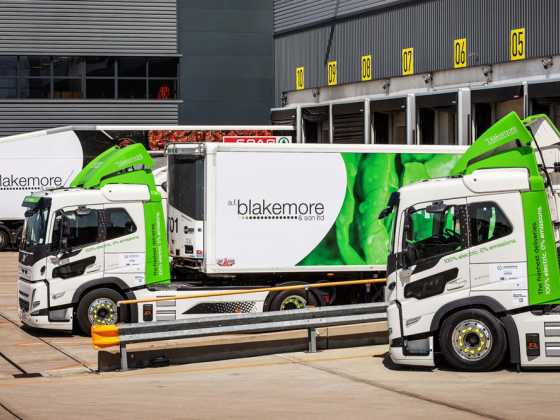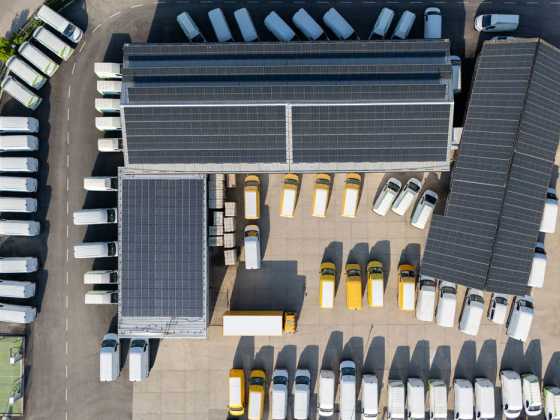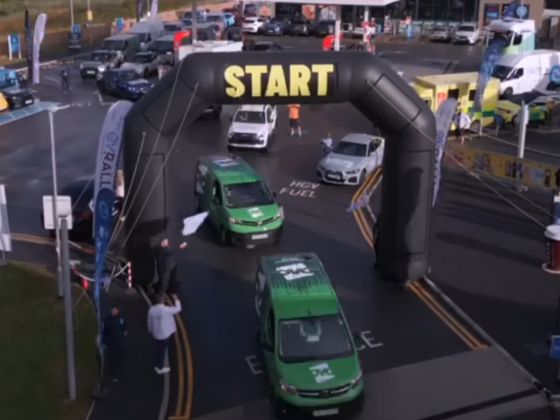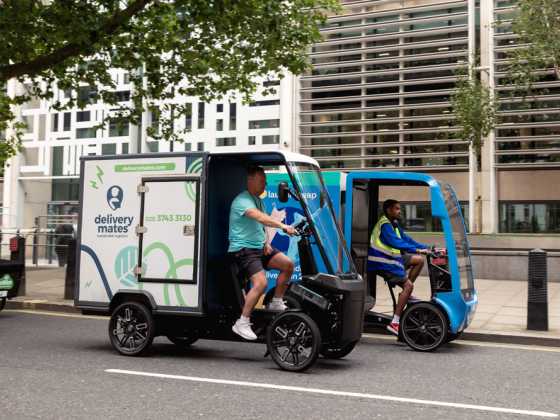When four wheels just doesn’t do it
There are growing benefits for businesses having a fleet on two wheels, such as less time on congested roads, cost savings and a reduction in CO2 emissions. The Motorcycle Industry Association’s Stevie Muir shares her thoughts
 As a driver, you’re likely to have spent at least some time sitting in traffic recently. And while you were there, you were probably passed by a motorcyclist, filtering slowly to the front of the queue. How did you feel about that?
As a driver, you’re likely to have spent at least some time sitting in traffic recently. And while you were there, you were probably passed by a motorcyclist, filtering slowly to the front of the queue. How did you feel about that?
Filtering is one of motorcycling’s best kept secrets and is probably the reason why riders score so highly in happiness tests – a fact endorsed by a one-off travel survey by the Office for National Statistics. Commuting via motorcycle has no negative impact on wellbeing for journeys up to half an hour, and after that it is negligible. This was in contrast to those travelling by car, bus, cycling and those walking, who all experience reduced contentment after just 15 minutes.
This revelation received little publicity when the survey was released; perhaps in keeping with the perception that motorcycling is in decline. It isn’t. It is worth examining why this mode of transport is gaining popularity and to look at recent developments which make it easier than ever to make powered two wheelers (PTWs) work in a fleet context.
The power of filtering
Let’s start with filtering, which is key to the ability of PTWs to cut through traffic.
Filtering gives motorcyclists a huge advantage, saving time, money and reducing the environmental impact of each journey. It is legal in the UK and according to recent US research, it increases rider safety, so long as it’s done just a little faster than stationary or slow moving traffic.
Long established users of motorcycle fleet include the police, ambulance service, AA breakdown services and Blood Runners, who courier lifesaving products between NHS hospitals out of normal working hours. Whilst these examples all need to cut through traffic quickly to assist with emergency situations, the ability to reduce time spent in traffic is becoming increasingly important to all businesses.
Case studies
Being able to filter on the M25 and other congested roads in the capital has cut costs by 50 per cent for body shop repair specialists DWS Automotive.
The company’s assessors work between 10 body shops strategically located around the M25 and were looking for shorter journey times and greater mobility than their small cars afforded.
Working a fleet of Honda CB500Fs increased productivity nearly twofold. The company no longer pay congestion charges, toll fees or parking. Fuel costs have been halved and the company has eliminated leasing costs, as the OTR price was the same as the car deposit.
Steve Kenward, CEO of the Motorcycle Industry Association (MCIA) explains that:“Filtering allows motorcyclists to navigate congested roads in the time you’d normally expect to move in free flowing traffic.”
To prove this point, the MCIA tested how effective motorcycles were in rush hour compared to other modes of transport, by staging a series of ‘city challenges’ during Ride to Work Week in June. Journey times were compared for six of the UK’s most congested cities – Manchester, Birmingham, Brighton and Hove, Bradford, Leeds and Leicester. For each, it measured the times taken by a motorcyclist, car driver, public transport user and, where appropriate, a cyclist – to see which was quickest, without breaking any speed limits.
Kenward went on: “In every case, the motorcyclist reached the destination first, usually in half the time taken by the car driver, who always struggled to find parking.”
Use is increasing
Motorcycling is becoming more popular – a little known fact outside the industry. There are now nearly twice as many motorcycles, scooters and mopeds licensed (or license exempt) for the road than there were twenty years ago.
In 1994 there were 720,900 and now there are 1,326,500 and this trend is likely to continue with congestion as a major driving force. Of all new sales last year, nearly 50 per cent were for smaller capacity machines, likely to be used for commuting. This fits with reports from dealers that they are making an increasing number of sales to families swapping a second car for a small motorcycle, moped or scooter to save time and money.
New sales for 2014 rose more than 10 per cent on the same time last year and attendance at motorcycle shows is up by the same amount. Footfall at shows is traditionally seen as a barometer to predict sales for the coming year. New registrations are continuing to rise, with growth 14 months in a row.
Two wheels beat four
According to the Confederation of British Industry (CBI), congestion is set to increase by another 50 per cent within a generation.
Simon Davies, manager of Honda’s new fleet programme, explained: “Incorporating vehicles which can cope with rising congestion could give you an immediate competitive edge and will help with any long term goals or legislative requirements to reduce your carbon footprint.”
Davies added: “Most small motorcycles, scooters and mopeds already meet the proposed ultra-low emission requirements. Larger machines pollute less than cars of equivalent engine capacity because they spend less time in traffic for each journey. Motorcycles often have access to bus lanes and are exempt from the congestion charge and the workplace parking levy.”
Motorcycle fleet dealers
Honda recently became the first manufacturer to introduce the UK’s first specialist motorcycle fleet dealer network.
Six dealerships had to undergo stringent selection and training to make sure they were able to offer corporate clients a full service, from advising on the right vehicles to what protective clothing and training is needed.
Simon Davies, offered some stats surrounding the Honda Vision 110cc, which is proving very popular for fleet customers.
Davies said: “With good second hand values, VED at just £17, 160 miles to the gallon and just 44.6 grams of CO2 per kilometre – you can see why fleet managers are keen to investigate further. Honda fleet dealers can also give a full breakdown on cost, and can provide financial packages similar to the ones available for cars and vans, which allow you to make direct comparisons.”
A local solution
There is evidence to suggest more motorcycles, scooters and mopeds will help reduce congestion for all road users. A Belgian study showed that when just 10 per cent of drivers swapped to a PTW, congestion was eliminated for all road users by 40 per cent.
Local authorities are beginning to wake up to this idea. Northamptonshire County Council recently carried out a scoping study to find out why more people in the county don’t use motorcycles and to identify any barriers for those who do. On its website, it states the findings could help ‘integrate motorcycling into the County Council’s sustainable transport strategy, which also covers policies on walking and cycling routes as well as bus travel.’
Wheels 2 Work
A number of local authorities are already endorsing the use of PTWs in low cost transport schemes, by making local sustainable transport funding available for Wheels to Work. There are 40 schemes across the UK, up from a total of 23 just two years ago, with several others in development.
Wheels 2 Work offers the loan of a small motorcycle, scooter or moped to people who would otherwise have no access to private or public transport. It allows them to get to work or college, or to carry out a job which involves travelling, for example mobile carers.
Key developments in training
Good training is crucial to keeping riders safe. The MCIA recently launched courses for training businesses and their instructors through the newly established Motorcycle Industry Accreditation Centre. These offer DVSA approved training which is quality assured by the Institute of the Motor Industry (IMI). It means corporate clients can now easily identify high quality trainers.
The businesses which are MCIAC approved are visited annually to check high standards are upheld and every single customer is surveyed – again to monitor standards.
These courses have been introduced ahead of any compulsory requirement to do so and before anything similar has been launched for driver training.
More is less
Perception of safety is obviously a consideration where motorcycles are concerned and this has been on the national agenda recently, with the release of a joint policy document from the MCIA and the Association of Chief Police Officers (ACPO). Together they have explored the idea that encouraging motorcycling would result in better safety outcomes for all road users.
Motorcyclists or those who have had experience of riding a PTW typically develop superior hazard awareness, and have a better understanding of the Highway Code. Carole Nash insurance recently launched a product aimed at car drivers who are motorcyclists, which builds on work done by another MCIA insurance member who found that motorcyclists claim less on their car insurance and when they do their accidents are less serious.
The MCIA is adamant that two wheel vehicles are the future for personal and business transport and their increasing use will result in safer roads for all.
Further information
www.mcia.co.uk






